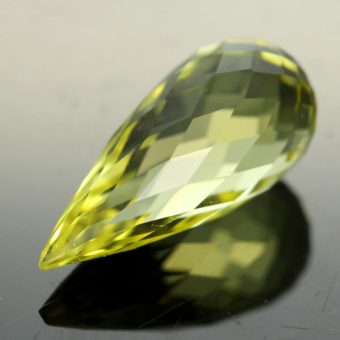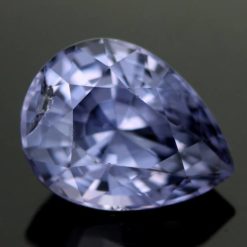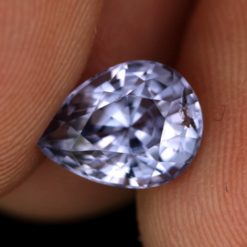No products in the cart.
Gemstone Information
All About Briolette Gemstones — The Gem Fit For Royalty!
Have you ever found yourself gazing in awe at the sparkling reflection of a briolette cut gemstone? If so, you might not have known the name for it, but you likely took notice of its unique shape and sparkle. Briolette gemstones are a pear-shaped or oval gem covered in glittering triangular cuts. The entire surface of the gemstone has geometric cuts that beautifully compliment jewelry.
What makes briolettes sparkle so bright? Those precisely patterned facets create an even distribution of light across the stone. What does that mean? Sparkle, sparkle, sparkle!
A world of reflection is beaming inside of a briolette gemstone. What is a briolette and what gives it that elegant sparkle?
In this article, we’re highlighting the traits that make briolette gemstones so unique!
What is A Briolette Gemstone?
The name, “Briolette” describes a “drop cut” gemstone shape. Briolettes are a mesmerizing gemstone cut that blankets the stone in geometric shapes. Instead of having cuts around the crown of a gem, like a round or princess-cut, briolettes are covered in geometric cuts.

Why? This special style of gem faceting maximizes the amount of light reflecting from the gem. When you wear a briolette, it moves and radiates a spectacle of gorgeous sparkle! Which is why they’ve been a prized gemstone for centuries.
So, where did the style of briolette gemstone cutting originate? Let’s explore!
Where Are Briolette Gemstones From?
In the jewelry and gemstone market, current trends favor round and pear diamond cuts. Was it always so? Not at all. In fact, the nobility and royalty favored the briolette cut during the 17th century. It’s easy to see why this glamorous style became the object of affection for prominent figures. Can’t beat that glamorous sparkle! Even with its popularity in royal courts, briolettes aren’t exactly diverse. That’s because they don’t have a face or flat surface to set in rings and necklaces.
As such, briolettes moonlit as gorgeous earrings and accent stones for diamond necklaces. There’s a reason why Napoleon gifted Empress Marie Louise with a jaw-dropping diamond necklace. The pièce de résistance? 10 sparkling briolette gemstones. This relic is currently on display at the Smithsonian Institution in Washington, D.C.
The craftsmanship of briolettes made them perfect for royalty, but they weren’t accessible to the masses. And over time, they slipped out of style. It wasn’t until the glitz and extravagance of the roaring 20s that briolettes circled back in style. Along with the lavish intrigue of art deco, briolettes gleamed in the spotlight of flapper-era glamour.
In spite of this resurgence, briolettes remain less popular than traditional cuts. The reality is that briolettes are quite expensive. Still, you can’t put a number on the vivid spectrum of light that sparkles from briolettes.
How Are Briolettes Cut?
It’s clear that the uniqueness of a briolette gem comes from the way it’s cut. Fun fact: briolette cutting is the oldest technique for cutting gemstones. How do cutters shape these intricate gemstones? There are actually three ways of cutting in this style, but one method is the most common: Pin-Cap.
The pin-cap cutting method involves a cross-drill and pin to cut the facets on the surface of the gemstone. Precise craftsmanship must ensure the gem doesn’t crush or chip during the process. After cutting the gem, it’s examined to ensure the flatness, angle, and cut matches the diameter of the stone.
As you can see, perfectly cut briolette gemstones are difficult to manufacture. This is in large part due to their delicate, tear-drop shape. It takes an extremely gifted and skilled artisan to bring these magnificent cuts to life. So, what types of gemstones can we expect to see cut briolette style?

What Gemstones Are Briolette Cut?
Can any gemstone be cut briolette style? The most commonly cut briolettes are diamonds. You’ll also find briolette cut sapphires, emeralds, quartz, rubies, topaz, and turquoise gems. Why? All these gem families are soft enough to shape but strong enough to withstand the cutting process. Unlike other gemstones that are set into protective settings, briolettes are exposed to the elements. The beads are more vulnerable, so they need to be a strong material to resist chipping and scratching.
A prime example is quartz briolette. These can be either amethyst or citrine, as each gem in the quartz family is durable and equipped to sparkle long-term. The most important thing to do when selecting gemstones to cut briolette style is to choose a strong material that is also malleable. The result? A glittering gemstone unlike any other!
What Are Briolette Beads?
These are loose gemstones that exhibit stunning clarity, brightness, and patina. Briolette beads are loose and come in a variety of shapes and sizes. What’s more, each comes pre-drilled so all you need are the materials to string the beads together and a solid adhesive. This makes them the perfect candidates to make jewelry with! If you love the aesthetic of briolettes and are a crafty jewelry maker, you’ve got to DIY some gorgeous briolette jewelry items!
Briolette Jewelry Trends
Not one for arts and crafts? No sweat! Briolette jewelry is widely available. Right now, one of the most popular trends is to wear briolette beads with tassels. This creates a very chic, boho look.
Another popular style is layered briolette necklaces. This style is the personification of a classic statement accessory. Wear a briolette necklaces to dress up a casual outfit, or adorn an evening look with a briolette diamond necklace like Empress Marie Louise!
The beautiful quality of briolettes is that they are extraordinarily unique. Ready for a dalliance with briolette gemstones? Get ready to dazzle because no matter how you wear them, people are going to take notice!















